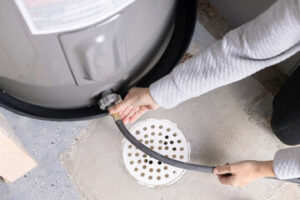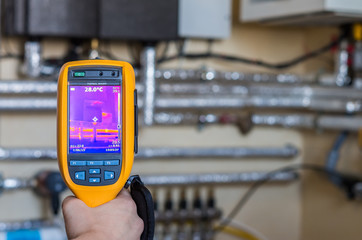Important Components of Water Heater Installation
A traditional water heater has a large insulated tank with gas or electric heating elements inside. The hottest water rises to the top and is fed into the tap through a dip tube.
Before starting any work on a new water heater, read the printed installation instructions and safety warnings. Use proper techniques and follow all local building, plumbing, and electrical codes. Contact Water Heater Installation Denver for professional help.
Venting is a critical part of any water heater installation. It allows the water heater to vent the heat, gases, and byproducts of combustion out of your home to reduce carbon monoxide levels and protect against fire hazards. Venting is important because it also helps control indoor humidity and airborne contaminants, both of which can have negative health consequences.
Most gas and liquid propane tank water heaters are vented, as are some electric tankless water heaters. During the installation process, it is important that the venting be correctly installed to prevent backdrafting and other safety risks. It is also important that the vent duct be sloped properly to ensure adequate flow and eliminate moisture infiltration, which can lead to water damage within your home.
Atmospheric venting is the most common type of venting for water heaters. It consists of a vertical or upward-sloping vent duct that ties into a common vent pipe outside the house. It works on the principle that hot gases rise, so it is important that the duct work be free of obstructions or misalignments. If the duct is too low or too high, it can cause blockages or backdrafting that can release excess heat and fumes into your home.
A professional installer will be able to identify any issues with your current venting system and make necessary adjustments to ensure that it meets all local building codes. For example, modern homes with tight seals may require a new type of venting system such as direct venting, in which a double-chambered vent pipe carries exhaust gases out of the side of the home while fresh air is drawn in through the other side of the vent. This is a safer option than the atmospheric venting, which can be subject to backdrafting and other problems.
Venting is not just for safety reasons; it can also save you money on your energy bills by allowing your new water heater to run more efficiently. In addition, proper ventilation can help reduce condensation on the hot water heater’s metal surface, which can otherwise result in scale buildup and corrosion that could shorten the life of your water heater.
Carbon Monoxide Detectors
Carbon monoxide (CO) is an odorless, colorless gas that can kill you in high concentrations. It is produced by fuel-burning appliances like water heaters, furnaces and stoves, as well as by wood-burning fireplaces. Carbon monoxide is a byproduct of combustion and is normally vented away from homes through vents and chimneys. When these systems are faulty or poorly maintained, CO can build up in a home. Carbon monoxide detectors can warn you of dangerous levels by sounding an alarm when they sense the presence of the deadly gas.
CO poisoning often goes unnoticed because symptoms resemble the flu: headaches, dizziness, nausea and mental confusion. Symptoms become more severe with prolonged exposure, and can eventually cause unconsciousness and brain damage. Children, the elderly and pregnant women are particularly susceptible to CO poisoning.
A malfunctioning water heater or a damaged, corroded vent pipe can produce CO concentrations that are hazardous to human health. Fortunately, carbon monoxide poisoning is preventable through proper maintenance and regular inspections of all gas appliances like water heaters.
Detectors work by using electrochemical sensors to monitor the CO concentrations in the air. When carbon monoxide enters the sensor’s gas-permeable compartment, the chemical inside it changes, causing an alarm to sound. Several types of detectors are available, with different designs and sensors that employ a variety of methods to gauge CO levels. A professional will be able to recommend the best units for your needs.
The National Fire Protection Association recommends installing CO detectors on each level of your home, as well as outside rooms where people sleep. There may also be local or state codes that dictate placement and number of detectors required in your home.
If your CO alarm sounds, open windows and doors to improve ventilation and clear the air of the dangerous gas. If you notice any of the symptoms of carbon monoxide poisoning, call 911 or your local emergency services and exit the building immediately. Contact a qualified technician to inspect your home’s venting system, chimney and vent stacks for blockages caused by animal nests, cracks, holes or cave-ins. Also, have your furnace, water heater and any other fuel-burning appliance serviced annually to ensure they are operating correctly and are not releasing carbon monoxide into your home.
Safety Valve
The safety valve is one of the most important water heater components in your home. It safeguards you and your loved ones by alleviating excess pressure, preventing disasters such as explosions or leaks. It’s essential to have this valve installed properly, and to test it regularly to make sure it is functioning correctly.
A pressure and temperature (T&P) relief valve is designed to relieve water at both a set amount of pressure, typically 150 psi, and a set temperature of 210 degrees Fahrenheit. It does this by opening when either of these conditions are met, which allows excess water to flow out of the valve and lower the pressure inside of the tank.
Your T&P relief valve should have a discharge line attached to it, which carries the water that is released from the valve away from the point of release and into a safe place of disposal. The discharge line should be a standard length of at least 6’, and must pitch downward from the valve. The discharge pipe should also be the same size as the valve’s discharge connection throughout its entire length to prevent flow constriction. It is recommended to avoid using tee fittings, which will limit the diameter of the discharge pipe and could impede its ability to open and discharge in an emergency.
If you find that the discharge tube is constantly leaking or it is displaying other signs of trouble, such as excessive water pressure in the system, it’s best to contact a professional plumber to examine and resolve the problem. The professional plumber will be able to perform a complete inspection of the discharge tube and the safety valve to determine what the source of the problem is.
The safety valve should be operated at least once a year to make sure the waterways are clear of mineral deposits that can build up and render it inoperative. The valve lever should snap back down after it is released, and if it does not, the valve should be replaced. A professionally-installed and properly-functioning water heater pressure relief valve will be able to protect your family and property for years to come.
Professional Installation
A professional installation is not only necessary to ensure that water heater connections are done correctly, but it also helps prevent costly repairs and a higher energy bill. Professionals are well-versed in local codes and permit requirements for water heater installations, so they’ll ensure compliance and obtain the proper permits. Moreover, they have access to the specialized tools needed for this job and can complete the installation in less time.
Water heater installation is complex, especially if your home’s gas and plumbing lines require modification or extension. A professional can help you assess the project and estimate the costs before beginning the work to avoid surprises. Additionally, professional installers are able to troubleshoot problems with your existing water heater and make recommendations that may save you from having to replace it altogether.
Professional installation often comes with warranty protection, which can protect your investment and reduce long-term expenses from costly repairs or replacements. Professionals are also familiar with manufacturer guidelines for quality and safety, so they can offer advice to maintain the integrity of your water heater and its components.
Do-it-yourself videos are a great way to learn, but there’s no substitute for experience when it comes to installation. Even a single mistake can cost you hundreds in repairs or wasted utilities. A plumber knows exactly how to install your water heater correctly the first time, avoiding a sleepless night or expensive repairs.
In addition to saving money on repairs and utilities, a professional plumber will make sure the settings are correct, preventing bacterial growth or overheating. They’ll also know how to fix any issues with the unit and give you tips on maintenance.
Professionals can also help you choose the ideal model for your needs, based on your home’s size, budget, and other factors. They can even take the old unit away and dispose of it for you, making your life easier!

